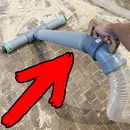Introduction: Easiest Woodworking Mallet?
Are you a woodworker? Do you have a woodworking hammer then?
If the answer was yes to both then you are good to go but if it was no to just one, then this instructable is just right for you!
Let me show you how to make a proper woodworking mallet for cheap and just in one hour! ( It took me 5 hours as I was making 3 of them while photographing, videotaping and drinking beer :D) But you might ask "why do I need one, why not just use a regular metal hammer?" Well, the answer is simple - wood is soft and if you pound it with any material stronger than itself it leaves dents and believe me, nothing is worse than hammer marks on your woodworking project! That's why I like to make my own woodworking mallets from materials readily available in my scrap bin and hardware store. And in fact, I like to keep several mallets with me at all times when working since I tend to lose them a lot. This is why I designed this super simple, yet super reliable woodworking mallet design that will not let you down!
A few years ago I posted another mallet design that was made from firewood. It was great in theory but practically not so much since the wood I used could not take the pounding and the handles just broke. You can see the post here!
Do you think you have an easier woodworking mallet design? I would love to see your design in the comments!
But enough talk, let's get started!
Step 1: What You Will Need
The materials list for this build is pretty short!
- Square material. This can be a premade stud like you see in the picture (100x100mm) or you can glue many smaller pieces together to create the same thing. All the wood I am using is pine ( Pinus sylvestris) as this is the cheapest and most available type of wood here. A bonus is also that it is softwood. It might also make dents in your workpiece when you are using hardwood for the mallet.
- Round pole. This I had to actually buy since I wanted it to be comfortable in hand. In the hardware store, I tried holding different sized wooden poles and felt which one would feel the most comfortable. I ended up with one that was around 28 mm in diameter
- Optionally you could also add Cork board on each end of the hammer. This will soften the blow and further ensure dentless workpiece.
- Wood glue and linseed oil
As always I like to say that the best tool is the one you have, so be creative! You do not need to have all the tools that are named down below!
- Table saw and/or hand saw
- Drill press/cordless drill with a spade bit (similar diameter as round pole)
- Disc sander and/or regular sandpaper
- Two clamps and two scrap boards for glueing the cork boards
Step 2: Cut
Cut the square material to length. It can be anything from 10 to 30 cm depending on how big and how heavy of a mallet you want. The one you see in the photos is 18 cm long with the handle length of 25 cm.
Now this could be it and you could just leave it like that but I suggest to also knock off the edges to give it a more pristine mallet look. Turn table saw blade to 45 degrees and make the cuts. Be sure to leave one face wide enough (28 mm) to drill the hole for the handle. Be careful with the saw! Use push sticks!
Step 3: Drill and Sand
Next up mark the centre of one of the faces and drill a hole for the handle. Drill it as deep as possible to maximise glue surface. I personally do not like to drill the hole all the way through but you could if you fancied.
Give the mallet head nice sand to get rid of all the saw marks. A belt sander or disc sander is ideal for this but sandpaper with a sanding block and lots of elbow grease will work just as well!
Step 4: Glue
Gut the round pole to length with a hand saw.
If you do not have the right sized spade bit (like I did) and the round pole won´t fit in the hole do the following. Mark the centre of the pole and drill a small hole. Take a screw and cut its head off and attach it to a drill. Screw it in and voila - you just made a small lathe! Use rough sanding paper (60 grit) to decrease the size of the round pole until you get a perfect fit. You know you have a perfect fit when the pole goes into the hole without too much pressure (has to have room for glue too) and when removed makes a nice pop sound like the weird guy in the Hot food meme.
Next up gut some lengthwise grooves on the end. This helps to guide the extra glue out. Make sure the grooves are not too long to be later visible.
Apply glue and leave it to set! No clamping needed really.
Step 5: Cork and Roundover
If you are doing fine woodworking then you might want to consider adding extra cushioning on your mallet. Glueing a cork board on each end does exactly that! Apply glue and use two scrap boards to get even pressure all around the surface. Cut the extra off with a carpet knife (x-acto knife).
Next thing to do is to round over the corners. Again, you could do it with only sandpaper but I chose a faster method and used round over bit on my homemade router table. Also, round over the end of the handle (but do not do it with a router - too dangerous)
And the very last thing to do is to give your hammer a coat of linseed oil. This protects the hammer from dust and wood glue and also gives it a nicer look!
Step 6: The End!
And that is it, folks! As you can see I have almost an army of woodworking mallets now! Easy, fast and super reliable!
Do you think you have an easier woodworking mallet design? I would love to see your design in the comments!
It would be awesome if you also voted for me in the contest - I would really appreciate it!
Leave a comment if something is left unclear or you just want to point something!
All the best,
Andu

Participated in the
1 Hour Challenge













